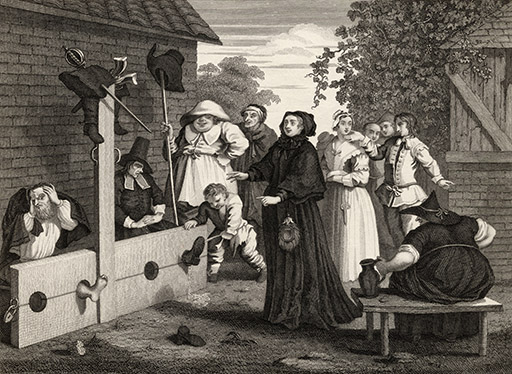3.2 Historians and the Bloody Code

Having undertaken some research yourself in the previous activity you have already found that the Bloody Code did not operate ‘as advertised’. In fact there was a lot of discretion and variability in verdicts, sentences and the carrying out of sentences. How should historians make sense of the clear gap that existed between the letter of the law and what actually happened? Let’s start with an established idea about the Bloody Code that dominated the writing of criminal justice history for most of the nineteenth and twentieth centuries.
The Whig view of history
The ‘Whig’ (or ‘Whiggish’) view of history comes from the old term for political Liberals (Whigs) and means an understanding of history as an evolutionary process. This view sees the history of any given subject as an increasingly civilising and evolving process leading to the rational and ‘better’ present now. To give an example; early Victorian Whigs (Liberals) argued that it was more civilised and rational for society to imprison people and correct their behaviours than to whip them or place them in the stocks. The development of the law and punishment was seen as progressing from disorganised brutal chaos, often called a ‘lottery’, towards a better and more rational ‘now’.
The Whiggish view of history tends to explain all historical developments as either moving towards, or as interruptions on the journey towards, some goal or improved ending. The Whig view of history emphasises moral improvement, rationalisation and institutional organisation (all quite Victorian!) and it lasted up until the 1960s. Today’s historians try to understand periods of time in the past as valuable to study and understandable for themselves rather than as an explainable stage of our journey to the here and now. The Whig view was a very useful tool for explaining things that were historically quite contradictory though!
Returning to the Bloody Code, for example, we know that a great number of crimes were punishable by the death sentence, but by the early nineteenth century this was not working as a deterrent because crime, especially theft, remained widespread. Through the eighteenth and nineteenth centuries, the use of hanging declined and non-violent property crime was increasingly punished by transportation or imprisonment. According to the Whig view of history, the use of hanging declined because the Bloody Code was illogical, hanging was an uncivilised spectacle and transportation or imprisonment were more humane. This explanation of an increasingly civilised society mirrored the arguments of the penal reformers in the 1820s and 1830s who wanted greater emphasis on reforming criminals and a prison building programme to do it in. From the 1970s onwards, some historians questioned this Whiggish explanation and their research looked closely at the Bloody Code and how the law operated.
